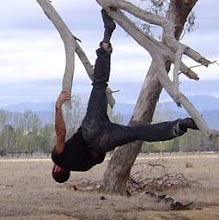 In Sydney the traditional communities (Cadigal) used the fibres for basket making and string, and the seeds were ground up and cooked over coals to make a dense cake.
In Sydney the traditional communities (Cadigal) used the fibres for basket making and string, and the seeds were ground up and cooked over coals to make a dense cake.
Tuesday, January 26, 2010
Mat Rush (Lomandra Longifolia)
Lomandras are native to about half of this continent, excluding the Northern Territory and Western Australia. It is an extremely hardy plant and can survive in a wide range of climates and thrive in a variety of soils including sandy, swampy or clay based, such as ours.
 In Sydney the traditional communities (Cadigal) used the fibres for basket making and string, and the seeds were ground up and cooked over coals to make a dense cake.
In Sydney the traditional communities (Cadigal) used the fibres for basket making and string, and the seeds were ground up and cooked over coals to make a dense cake.
 In Sydney the traditional communities (Cadigal) used the fibres for basket making and string, and the seeds were ground up and cooked over coals to make a dense cake.
In Sydney the traditional communities (Cadigal) used the fibres for basket making and string, and the seeds were ground up and cooked over coals to make a dense cake.
Thursday, January 21, 2010
A model forest for food
Meg and I were just in Sydney where we visited the Botanical Gardens to do some research on both Indigenous and exotic foods for a forthcoming project. Stay tuned, but in the meantime check out these Pummelos!




Friday, January 8, 2010
A goose hook
We headed to the lake today.
Wednesday, January 6, 2010
Public fruit - social warming
About one year ago I gleaned some early season cherry plums with my friend Pete in Castlemaine, which is a forty minute drive from here. My friend Jason had initially supplied us with a map of where to find them. Cherry plums are probably the first stone fruits to come into season in this region, and we've just discovered a tree about a four minute walk from here. As this lovely specimen is doing so well, survives only on intermittent water from the gods and its own self humus for nourishment, bears delicious fruit free of charge and pesticides, and is growing in the same micro-climate as our own we reckon it's probably a good idea to dry some seeds and attempt to propagate them for future produce.

Until recently our south boundary has bordered a vacant lot, however it has been sold and our new neighbours are getting ready to build. A food producing screen or fence that both sides can harvest could be a nice idea, so I'm going to grow these seeds and suggest this as another type of social warming fence.


Until recently our south boundary has bordered a vacant lot, however it has been sold and our new neighbours are getting ready to build. A food producing screen or fence that both sides can harvest could be a nice idea, so I'm going to grow these seeds and suggest this as another type of social warming fence.

Tom up Tom down
After reading Masanobu Fukuoka's The One-Straw Revolution I decided to conduct an experiment with our tomatoes this year. Fukuoka claims that no plant needs to be staked, pruned or manipulated in any way to give a robust crop. He maintains that just as with any natural farming or gardening system the quality of the soil is of utmost importance to improve productivity and keep pests at bay. He does add however that in the case of already pruned or manipulated plants and trees, such as orchard fruit trees, intervention needs to continue because the risk of disease is high. He is suggesting here, although this is only my interpretation, that one can not easily make wild the cultivated and civilised. I guess this is the problem with an anti-ecological, pro growth-capitalist school system. It churns out young cultivated adults disembodied from wild systems and free-ranging, where wildness is replaced with contained, overly supervised play. The rise in self-harming among young people is possibly one manifestation of this containment.
This year I am planting several varieties of tomatoes through the garden, in various soils and in various sun and shade positions. I'm also staking some and leaving others to grow along the ground at their own will. So far the two strongest plants with fruit already on them are one of each. Both are growing in reasonably developed soil, that are heavily mulched and semi-shaded by our large oak tree. Indigenous grasses, forest gleaned microbes and humus, and horse manure have been added to the environment. So far, between the staked and free-ranging, it's pretty even, however I have more than fifty tomato plants growing, of varying varieties, and will stake half as they develop. Stay tuned for the results later in the season.
 Above. Tomato (Grosse Lisse) staked.
Above. Tomato (Grosse Lisse) staked.
 Above. Tomato (Grosse Lisse) free-ranging.
Above. Tomato (Grosse Lisse) free-ranging.
This year I am planting several varieties of tomatoes through the garden, in various soils and in various sun and shade positions. I'm also staking some and leaving others to grow along the ground at their own will. So far the two strongest plants with fruit already on them are one of each. Both are growing in reasonably developed soil, that are heavily mulched and semi-shaded by our large oak tree. Indigenous grasses, forest gleaned microbes and humus, and horse manure have been added to the environment. So far, between the staked and free-ranging, it's pretty even, however I have more than fifty tomato plants growing, of varying varieties, and will stake half as they develop. Stay tuned for the results later in the season.
 Above. Tomato (Grosse Lisse) staked.
Above. Tomato (Grosse Lisse) staked. Above. Tomato (Grosse Lisse) free-ranging.
Above. Tomato (Grosse Lisse) free-ranging.
Labels:
Fukuoka,
natural farming,
pest controllers,
produce
Subscribe to:
Comments (Atom)


















